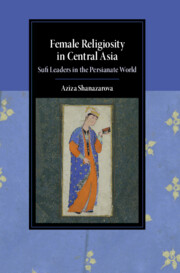Book contents
- Female Religiosity in Central Asia
- Cambridge Studies in Islamic Civilization
- Female Religiosity in Central Asia
- Copyright page
- Dedication
- Contents
- Figures
- Acknowledgments
- Abbreviations
- Introduction
- 1 Religion and Politics in Post-Timurid Central Asia
- 2 The Centrality of ʿAlidism in the Maẓhar al-ʿajāʾib
- 3 Locating the Great Lady within the Sufi Milieu of Sixteenth-Century Central Asia
- 4 The Chaghatay Book of Guidance
- 5 The Portrayal of the Great Lady in the Maẓhar al-ʿajāʾib
- 6 The Great Lady and Her Hagiographers
- 7 The Great Lady in Shrine Traditions
- Conclusion
- Bibliography
- Index
- Other titles in the series:
1 - Religion and Politics in Post-Timurid Central Asia
Published online by Cambridge University Press: 25 April 2024
- Female Religiosity in Central Asia
- Cambridge Studies in Islamic Civilization
- Female Religiosity in Central Asia
- Copyright page
- Dedication
- Contents
- Figures
- Acknowledgments
- Abbreviations
- Introduction
- 1 Religion and Politics in Post-Timurid Central Asia
- 2 The Centrality of ʿAlidism in the Maẓhar al-ʿajāʾib
- 3 Locating the Great Lady within the Sufi Milieu of Sixteenth-Century Central Asia
- 4 The Chaghatay Book of Guidance
- 5 The Portrayal of the Great Lady in the Maẓhar al-ʿajāʾib
- 6 The Great Lady and Her Hagiographers
- 7 The Great Lady in Shrine Traditions
- Conclusion
- Bibliography
- Index
- Other titles in the series:
Summary
Chapter 1 examines the Timurid-era tradition of ʿAlid devotion and its continuation under the early Shibanid dynasty. Tīmūr’s tombstone inscriptions leave no doubt regarding the ʿAlid orientation of the Timurids. The imagery of ʿAlī that links the Chingizid and Timurid genealogical trees in the tombstone suggests the preeminence of ʿAlī’s authority over the legacy of Chingiz Khan in the Timurid legitimation narrative. However, the decline of the Timurid dynasty in the early sixteenth century brought about large-scale religious and political turmoil in the Persianate world. The contest between the newly founded Shibanid and Safavid dynasties facilitated the Shibanids’ development of a self-conscious Sunni orientation in response to the militant Shiʿism promoted by the Safavids, thus furthering Sunni–Shiʿi antagonism.
Keywords
- Type
- Chapter
- Information
- Female Religiosity in Central AsiaSufi Leaders in the Persianate World, pp. 22 - 43Publisher: Cambridge University PressPrint publication year: 2024

